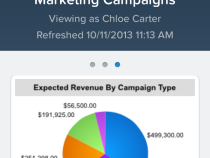
Salesforce.com is launching Salesforce1, its next-generation CRM platform that it has designed for developers, independent software vendors and customers to connect apps and third-party services such as Dropbox, Evernote and LinkedIn.
The mobile first environment symbolizes the company’s focus as a platform provider with the promise of connecting the enterprise to the billions of things that are increasingly capable of being programmed through APIs. It’s a big promise, especially considering that most companies are still finding their way with how to use mobile apps and services for marketing and sales.
Regardless, Salesforce is betting big on the Internet of Things (IoT) and will push its own take on the movement pretty heavily at its annual Dreamforce event this week in San Francisco.
In that vein, Scott Holden, VP of Platform Marketing, said in a phone interview on Friday that Salesforce is equating “things,” with customers a a way to show the connection to its platform. In fact, the company plans to ballyhoo this idea of the “Internet of Customers,” to show how IoT impacts the way the customer experience will be affected by the reality of this new connected world.
Behind the thick marketing spread is a platform that ties the company’s mobile app strategy into one connected dashboard, which gives it a foundation to serve four customer constituencies:
- Developers: Salesforce executives say Salesforce1 is an API-first environment. It has, according to Salesforce, 10 times more APIs and services for apps that point inward for budgeting, as an example, or outward, with apps for servicing customers such as in retail stores.
- ISVs: Companies such as Dropbox can build mobile apps on the new Salesforce1 AppExchange. The service also ties into Private AppExchange, which allows customers to manage their own private app stores.
- Admins: With Salesforce1, admins can use Force.com’s Visuaforce and custom actions for managing and distributing apps through a single mobile app platform.
The fourth community are the end users, who Holden says face an “app gap.” It’s this group who needs more apps to do small, simple and often customized tasks.
In March, CEO Marc Benioff said Chatter would become the primary interface for Salesforce.com. That focus on the activity stream is apparent in the screen shots the company is showing prior to tomorrow’s launch.
Salesforce1 boils down to four core themes, said Constellation Research Founder Ray Wang in an email interview over the weekend:
1. Customers can write once and deploy anywhere from mobile to connected enterprises.
2. The shift in thinking is interesting as Salesforce enters the world of things through its customers. Constellation sees more than 50 billion connected devices but at least 150 bullion connected endpoints by 2020.
3. A big hole is really the analytics. There’s a big data opportunity and big data business model opportunity here to enhance customer experiences, bench mark and broker data, and to build new business models around big data and analytics.
Salesforce.com always has something new and exciting to play up at Dreamforce. CEO Marc Benioff will be at his best, the consummate showman, telling the “customer” story to a reported 125,000 attendees. Embellish, much on attendance? Of course.
But I wonder what’s the main show, the new Salesforce.com platform or the parade of tech celebrities he’ll greet on the big stage? Yahoo CEO Melissa Mayer; Dropbox CEO and Founder Drew Stuart; Facebook COO Sheryl Sandberg and Deepak Chopra, the Indian physicist and author, all whi will have appearances.
Salesforce is a technology company with depth and a modern, perspective But it also has had a lacking mobile strategy that is hampered by its legacy platform. Salesforce1 embodies the company’s platform strategy and shows how the company is less of a CRM company than ever before. But it will face deep competition from a strong cadre of mobile CRM companies and expanding marketing automation companies such as Marketo, which has services similar to ExactTarget, the company Salesforce Salesforce acquired for $2.5 billion.

0 Responses
Stay in touch with the conversation, subscribe to the RSS feed for comments on this post.